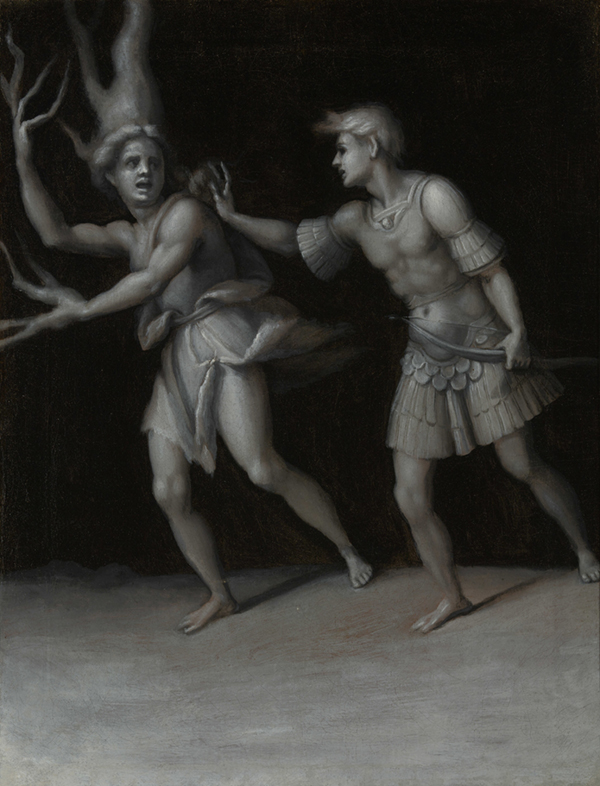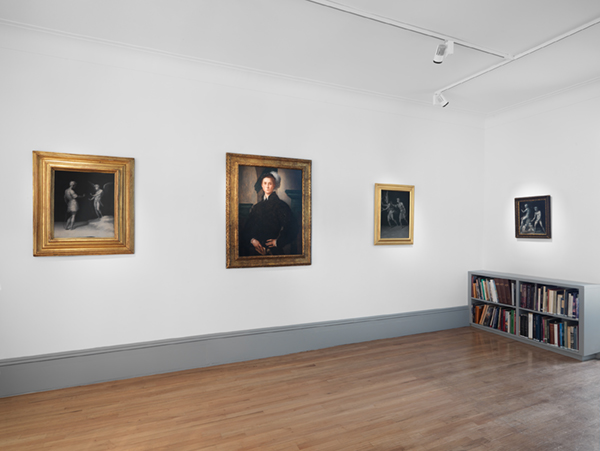BCMA Lends Pontormo’s “Apollo and Daphne”
By Bowdoin College Museum of Art
Apollo and Daphne, 1513, oil on canvas, by Jacopo da Pontormo, Italian, 1494–1557. Gift of the Samuel H. Kress Foundation. Bowdoin College Museum of Art.
For four weeks in January and February, the BCMA lent its painting Apollo and Daphne (1513) by the Florentine mannerist Jacopo da Pontormo (1494–1557) to a special exhibition Grey Matters at Nicholas Hall, a Manhattan gallery specializing in Old Master paintings. The painting has traveled beyond Brunswick on only a couple occasions since the Samuel H. Kress Foundation donated it sixty years ago in 1961. The BCMA was pleased to lend it on this occasion, for the research leading to this exhibition breaks new ground in an understanding of Pontormo’s artistic practice and the tradition of monochromatic art works created during the Renaissance.
The exhibition’s curator was Dr. Dennis V. Geronimus, an associate professor of art history at New York University who specializes in the art of the Italian Renaissance. In 2019, Geronimus contributed an outstanding essay about Apollo and Daphne to the BCMA’s new collections catalogue, Art Purposes: Object Lessons for the Visual Arts. You can read it here. In recent years he has become especially interested in those Old Master artists who created monochromatic works in various mediums. Pontormo’s Apollo and Daphne—painted in grisaille, a method of painting in grey monochrome, typically to imitate stone sculpture—is a great example of this tradition.
Previously scholars knew about only two works by Pontormo in grisaille: Cupid and Apollo (1513) in the collection of the Samek Art Museum at Bucknell University and the BCMA’s canvas. Recently a new work Adam and Eve (ca. 1515) was discovered, and Grey Matters brought together these three works for the first time—together with a host of related works by Pontormo and other Italian Renaissance artists. Geronimus’s new research is presented here on the exhibition’s website.
 In addition to gathering together these rare works, the exhibition also explored the concept of “paragone”—a debate begun in Italy in the fifteenth century about the superiority of painting or sculpture. Though many sculptors believed painting inferior because it lacked form, Leonardo da Vinci spoke in defense of the medium. In A Treatise on Painting, written in Milan in the late fifteenth century, he championed painting as a type of science and argued for its significance.
In addition to gathering together these rare works, the exhibition also explored the concept of “paragone”—a debate begun in Italy in the fifteenth century about the superiority of painting or sculpture. Though many sculptors believed painting inferior because it lacked form, Leonardo da Vinci spoke in defense of the medium. In A Treatise on Painting, written in Milan in the late fifteenth century, he championed painting as a type of science and argued for its significance.
A generation later the Florentine Pontormo engaged in this debate as well. Apollo and Daphne—commissioned by the Medici family to decorate a parade carriage—was painted to appear as a stone sculptural relief. While the painting depicts the moment in Ovid’s Metamorphoses in which the love-struck Apollo reaches out to Daphne as she is transformed into a laurel tree, it also participates in the debate about the superiority of painting or sculpture to best represent figures—whether from mythology or the natural world. As a painter, Pontormo sided with Leonardo, celebrating painting’s ability to imitate the human form.
When the BCMA reopens, we invite you to visit Apollo and Daphne in a new installation of its Old Master collection. Until then, please enjoy exploring Grey Matters on-line.
Frank Goodyear
Co-Director, Bowdoin College Museum of Art
Illustration: an installation view of Grey Matters at the Nicholas Hall Gallery, New York.